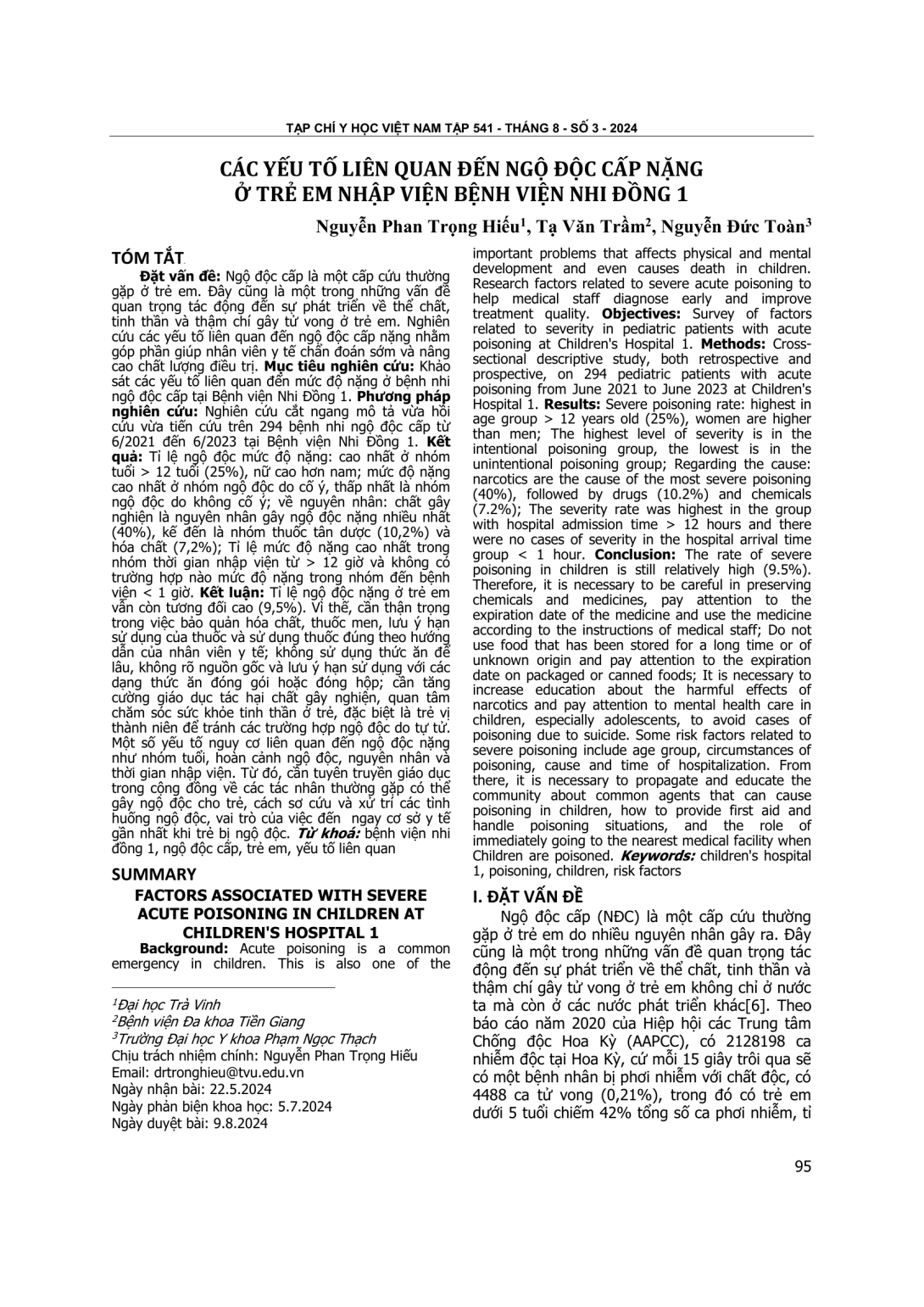
Khảo sát các yếu tố liên quan đến mức độ nặng ở bệnh nhi ngộ độc cấp tại Bệnh viện Nhi Đồng 1. Phương pháp nghiên cứu: Nghiên cứu cắt ngang mô tả vừa hồi cứu vừa tiến cứu trên 294 bệnh nhi ngộ độc cấp từ 6/2021 đến 6/2023 tại Bệnh viện Nhi Đồng 1. Kết quả: Tỉ lệ ngộ độc mức độ nặng: cao nhất ở nhóm tuổi > 12 tuổi (25%), nữ cao hơn nam; mức độ nặng cao nhất ở nhóm ngộ độc do cố ý, thấp nhất là nhóm ngộ độc do không cố ý; về nguyên nhân: chất gây nghiện là nguyên nhân gây ngộ độc nặng nhiều nhất (40%), kế đến là nhóm thuốc tân dược (10,2%) và hóa chất (7,2%); Tỉ lệ mức độ nặng cao nhất trong nhóm thời gian nhập viện từ > 12 giờ và không có trường hợp nào mức độ nặng trong nhóm đến bệnh viện < 1 giờ. Kết luận: Tỉ lệ ngộ độc nặng ở trẻ em vẫn còn tương đối cao (9,5%). Vì thế, cần thận trọng trong việc bảo quản hóa chất, thuốc men, lưu ý hạn sử dụng của thuốc và sử dụng thuốc đúng theo hướng dẫn của nhân viên y tế; không sử dụng thức ăn để lâu, không rõ nguồn gốc và lưu ý hạn sử dụng với các dạng thức ăn đóng gói hoặc đóng hộp; cần tăng cường giáo dục tác hại chất gây nghiện, quan tâm chăm sóc sức khỏe tinh thần ở trẻ, đặc biệt là trẻ vị thành niên để tránh các trường hợp ngộ độc do tự tử. Một số yếu tố nguy cơ liên quan đến ngộ độc nặng như nhóm tuổi, hoàn cảnh ngộ độc, nguyên nhân và thời gian nhập viện. Từ đó, cần tuyên truyền giáo dục trong cộng đồng về các tác nhân thường gặp có thể gây ngộ độc cho trẻ, cách sơ cứu và xử trí các tình huống ngộ độc, vai trò của việc đến ngay cơ sở y tế gần nhất khi trẻ bị ngộ độc.
Survey of factors related to severity in pediatric patients with acute poisoning at Children's Hospital 1. Methods: Cross-sectional descriptive study, both retrospective and prospective, on 294 pediatric patients with acute poisoning from June 2021 to June 2023 at Children's Hospital 1. Results: Severe poisoning rate: highest in age group > 12 years old (25%), women are higher than men; The highest level of severity is in the intentional poisoning group, the lowest is in the unintentional poisoning group; Regarding the cause: narcotics are the cause of the most severe poisoning (40%), followed by drugs (10.2%) and chemicals (7.2%); The severity rate was highest in the group with hospital admission time > 12 hours and there were no cases of severity in the hospital arrival time group < 1 hour. Conclusion: The rate of severe poisoning in children is still relatively high (9.5%). Therefore, it is necessary to be careful in preserving chemicals and medicines, pay attention to the expiration date of the medicine and use the medicine according to the instructions of medical staff; Do not use food that has been stored for a long time or of unknown origin and pay attention to the expiration date on packaged or canned foods; It is necessary to increase education about the harmful effects of narcotics and pay attention to mental health care in children, especially adolescents, to avoid cases of poisoning due to suicide. Some risk factors related to severe poisoning include age group, circumstances of poisoning, cause and time of hospitalization. From there, it is necessary to propagate and educate the community about common agents that can cause poisoning in children, how to provide first aid and handle poisoning situations, and the role of immediately going to the nearest medical facility when Children are poisoned.
- Đăng nhập để gửi ý kiến
